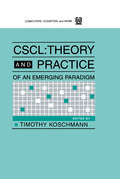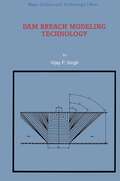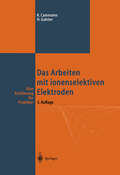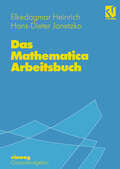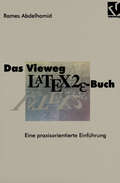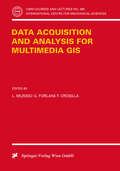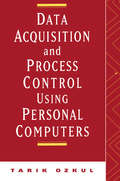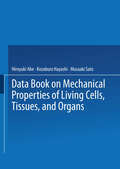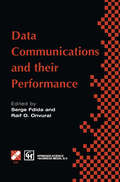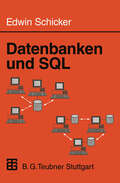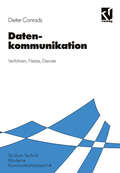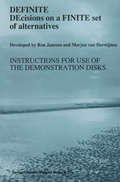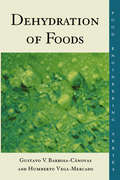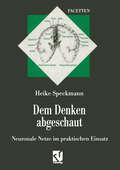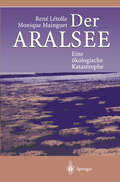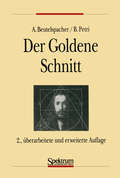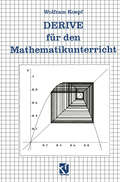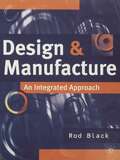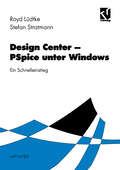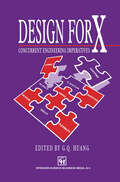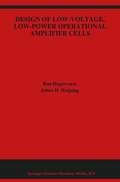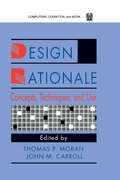- Table View
- List View
Cscl: Theory and Practice of An Emerging Paradigm
by Timothy KoschmannThis book, about a newly emerging area of research in instructional technology, has as its title the acronym "CSCL." Initially, CSCL was chosen as an acronym for Computer-Supported Collaborative Learning. However, some would argue that "collaborative" is often not a descriptive term for what learners do in instructional settings; further, as the field develops, the technology used to support collaboration may not always involve computers, at least not in the direct ways they have been used to support instruction in the past. To avoid getting bogged down in this terminological debate, this book uses CSCL as a designation in its own right, leaving open to interpretation precisely what words it stands for. The authors talk a great deal about the theory underlying their work. In part, this is because that is what they were asked to do, but it is also an indication of the state of the field. In an established paradigm in which the theories and methods are well agreed upon, such discussion is less central. CSCL, however, has not yet reached the stage of "normal" science. There is much to be worked out yet. This book is offered with the hope that it will help to define a direction for future work in this field. The chapters appear in alphabetical order (except for the introductory chapter and the afterword) -- not for lack of a better way to organize the chapters, but rather because the organizational possibilities are too numerous and this order does not privilege one over another. By not imposing a topical organizing structure on this collection, it is hoped that readers will feel freer to explore the chapters in a way that best suits their needs. COPY FOR BIND-CARD CD-ROM info ................................. There is an accompanying CD-Rom for this proceedings that will become available September 1998. Purchasers of the proceedings may obtain a copy of this CD-ROM at no cost by contacting Lawrence Erlbaum Associates, Inc. phone: (201) 236-9500 toll-free: 1-800-9-BOOKS-9 (1-800-926-6579) 9am-5pm EST fax: (201) 236-0072 e-mail: orders@erlbaum.com Web site: www.erlbaum.com address: 10 Industrial Avenue, Mahwah, NJ 07430-2262 The CD-ROM was funded through a grant from the National Science Foundation.
Cscl: Theory and Practice of An Emerging Paradigm
by Timothy KoschmannThis book, about a newly emerging area of research in instructional technology, has as its title the acronym "CSCL." Initially, CSCL was chosen as an acronym for Computer-Supported Collaborative Learning. However, some would argue that "collaborative" is often not a descriptive term for what learners do in instructional settings; further, as the field develops, the technology used to support collaboration may not always involve computers, at least not in the direct ways they have been used to support instruction in the past. To avoid getting bogged down in this terminological debate, this book uses CSCL as a designation in its own right, leaving open to interpretation precisely what words it stands for. The authors talk a great deal about the theory underlying their work. In part, this is because that is what they were asked to do, but it is also an indication of the state of the field. In an established paradigm in which the theories and methods are well agreed upon, such discussion is less central. CSCL, however, has not yet reached the stage of "normal" science. There is much to be worked out yet. This book is offered with the hope that it will help to define a direction for future work in this field. The chapters appear in alphabetical order (except for the introductory chapter and the afterword) -- not for lack of a better way to organize the chapters, but rather because the organizational possibilities are too numerous and this order does not privilege one over another. By not imposing a topical organizing structure on this collection, it is hoped that readers will feel freer to explore the chapters in a way that best suits their needs. COPY FOR BIND-CARD CD-ROM info ................................. There is an accompanying CD-Rom for this proceedings that will become available September 1998. Purchasers of the proceedings may obtain a copy of this CD-ROM at no cost by contacting Lawrence Erlbaum Associates, Inc. phone: (201) 236-9500 toll-free: 1-800-9-BOOKS-9 (1-800-926-6579) 9am-5pm EST fax: (201) 236-0072 e-mail: orders@erlbaum.com Web site: www.erlbaum.com address: 10 Industrial Avenue, Mahwah, NJ 07430-2262 The CD-ROM was funded through a grant from the National Science Foundation.
Dam Breach Modeling Technology (Water Science and Technology Library #17)
by V.P. SinghDams are constructed for economic development, and their construction involves large investments of money, and natural and human resources. Of the various types of dams constructed around the globe, earth dams are the most common type and constitute the vast majority of dams. When adam fails, it culminates in the sudden release of artificially stored water which, in turn, becomes a potential menace to virtually everything downstream. The dam failure may result in loss of life and property. In recent years, instances of dam failure in the world have been too many, and the resulting loss too high. As a result, dam safety pro grams have been developed in most countries of the world since the beginning of the nineteenth eighties. · Earth dams are more susceptible to failure than other types. The cause of failure is often either overtopping or piping. The modeling of dam breaching due to either or both of these causes is of fundamental importance to development of dam-safety programs. This book is, therefore, an attempt to present some aspects of earth-dam breach modeling technology. It is hoped that others will be stimulated to write more comprehensive texts on this subject of growing interest and importance. The book is divided into eight chapters. The first chapter is introductory and discusses some aspects of dams and dam failures in the world.
Das Arbeiten mit ionenselektiven Elektroden: Eine Einführung für Praktiker
by Karl Cammann Helmuth GalsterKomplett überarbeitet und auf dem neuesten Stand präsentiert sich die 3. Auflage dieses Erfolgsbuches. Schwerpunktmäßig werden diejenigen Methoden beschrieben, die speziell für ionenselektive Elektroden ausgearbeitet, wiederentdeckt oder entsprechend dem analytischen Fortschritt weiterentwickelt wurden. Wer Spezialelektroden im eigenen Labor herstellen möchte, erhält dazu praktische Anleitungen.
Das Mathematica Arbeitsbuch (Computeralgebra)
by Elkedagmar Heinrich Hans-D. JanetzkoNachdem Computeralgebra-Pakete wie Mathematica immer mehr Verbreitung finden, entsteht oft die Frage, welche mathematischen Probleme damit überhaupt angegangen werden können. Dieses Buch beschreibt die Mathematik, wie sie Studierende an Fachhochschulen oder Universitäten brauchen, an vielen Beispielen mit Hilfe von Mathematica. Damit lernt der Leser Mathematica nicht als Selbstzweck, sondern als Werkzeug zum Lösen seiner mathematischen Probleme kennen.
Das Vieweg LATEX2ε-Buch: Eine praxisorientierte Einführung
by Rames AbdelhamidDie leicht verständliche Einführung richtet sich nach wie vor an den Einsteiger, der sich rasch in LaTeX einarbeiten möchte. Erfahrenen Anwendern dient es als Nachschlagewerk.
Data Acquisition and Analysis for Multimedia GIS (CISM International Centre for Mechanical Sciences #365)
by L. Mussio G. Forlani F. CrosillaContaining 31 papers collected in five chapters, this book deals with different fields of application and the problems of modelling and organising data in structures, as well as the processing techniques of GIS data for queries to the system and the so-called Dynamic GIS. The authors cover data acquisition with low cost DGPS for road surveys, vehicle navigation systems, and robust statistical techniques applied to pre-processing, analysis and testing. They report on the testing and calibration of different scanners for GIS data acquisition as well as some original approaches to the automatic DTM generation for cartographic and close range applications. Finally, applications to the environmental monitoring and the use of different kinds of geodetic data in multipurpose regional GIS are shown.
Data Acquisition and Process Control Using Personal Computers
by Tarik Ozkul""Covers all areas of computer-based data acquisition--from basic concepts to the most recent technical developments--without the burden of long theoretical derivations and proofs. Offers practical, solution-oriented design examples and real-life case studies in each chapter and furnishes valuable selection guides for specific types of hardware.
Data Acquisition and Process Control Using Personal Computers
by Tarik Ozkul""Covers all areas of computer-based data acquisition--from basic concepts to the most recent technical developments--without the burden of long theoretical derivations and proofs. Offers practical, solution-oriented design examples and real-life case studies in each chapter and furnishes valuable selection guides for specific types of hardware.
Data Book on Mechanical Properties of Living Cells, Tissues, and Organs
by Hiroyuki Abe Kozaburo Hayashi Masaaki SatoA research project entitled Biomechanics of Structure and Function of Living Cells, Tissues, and Organs was launched in Japan in 1992. This data book presents the original, up-to-date information resulting from the research project, supplemented by some of the important basic data published previously. The aim of collecting the information is to offer accurate and useful data on the mechanical properties of living materials to biomechanical scientists, biomedical engineers, medical scientists, and clinicians. The data are presented in graphs and tables (one type of data per page) arranged in an easily accessible manner, along with details of the origin of the material and the experimental method. Together with its two companion volumes, Biomechanics: Functional Adaptation and Remodeling and Computational Biomechanics, the Data Book on Mechanical Properties of Living Cells, Tissues, and Organs is a timely and valuable contribution to the rapidly growing field of biomechanics.
Data Communications and their Performance: Proceedings of the Sixth IFIP WG6.3 Conference on Performance of Computer Networks, Istanbul, Turkey, 1995 (IFIP Advances in Information and Communication Technology)
by Serge Fdida Raif O. OnvuralThis is the sixth conference in the series which started in 1981 in Paris, followed by conferences held in Zurich (1984), Rio de Janeirio (1987), Barcelona (1991), and Raleigh (1993). The main objective of this IFIP conference series is to provide a platform for the exchange of recent and original contributions in communications systems in the areas of performance analysis, architectures, and applications. There are many exiciting trends and developments in the communications industry, several of which are related to advances in Asynchronous Transfer Mode·(ATM), multimedia services, and high speed protocols. It is commonly believed in the communications industry that ATM represents the next generation of networking. Yet, there are a number of issues that has been worked on in various standards bodies, government and industry research and development labs, and universities towards enabling high speed networks in general and ATM networks in particular. Reflecting these trends, the technical program of the Sixth IFIP W.G. 6.3 Conference on Performance of Computer Networks consists of papers addressing a wide range of technical challenges and proposing various state of the art solutions to a subset of them. The program includes 25 papers selected by the program committee out of 57 papers submitted.
Datenbanken und SQL: Eine praxisorientierte Einführung (Informatik & Praxis)
by Edwin SchickerDatenbanken entstanden ab etwa 1960 aus der Notwendigkeit, die logischen auf die immer größer werdenden Datenmengen zu vereinfachen und Zugriffe zu normieren. Wurden diese Datenbanken über mehr als zwei Jahrzehnte hin weg ausschließlich auf Großrechnern eingesetzt, so haben sie inzwischen ihren Siegeszug auch auf Kleinrechnern angetreten. Ermöglicht wurde dies aus dreierlei Gründen: erstens durch die enorm gestiegene Rechnerleistung der letzten Jahre, zweitens durch die Verwendung relationaler Datenbanken und drittens durch die Einführung grafischer Oberflächen. Die Anfang der 70er Jahre entwickelten relationalen Datenbanken ermögli chen eine einfache Erstellung und Programmierung. Grafische Oberflächen unterstützen den Anwender und Datenbankdesigner dank einer leichten Benut zerführung und anschaulichen Musterbeispielen, so daß auch dem interessier ten Laien diese Form der Datenhaltung mit all ihren Möglichkeiten offen steht. Der Laie sei aber davor gewarnt, größere Datenbanken ohne theoretische Grundkenntnisse selbst zu erstellen. Denn hier leitet sich der Datenbankent wurf in der Regel nicht mehr direkt aus der AufgabensteIlung ab. Doch nur ein guter Entwurf garantiert übersichtliche und optimale Zugriffe und ermöglicht je nach Bedarf Ergänzungen und Erweiterungen der Datenbank. Auch wird nur dadurch die Konsistenz und Integrität der Datenbank ermöglicht, so daß feh lerhafte, widersprüchliche und nicht mehr zugreifbare Datenbestände verhin dert werden. Grundlagen zu Datenbankentwurf und -programmierung sollten für den Datenbankprogrammierer daher selbstverständlich sein. Dieses Buch entstand aus mehreren Vorlesungen zu Datenbanken, die ich an der Fachhochschule Regensburg für Informatiker gelesen habe. Doch ich will auch den Nicht-Informatiker und interessierten Laien gezielt ansprechen. Dazu wird mit zahlreichen Beispielen die Theorie direkt in die Praxis umgesetzt.
Datenkommunikation: Verfahren - Netze - Dienste (Moderne Kommunikationstechnik)
by Dieter ConradsDas Buch bietet eine fundierte, leicht verständliche Einführung in die grundlegenden Verfahren der Übertragungstechnik und beschreibt alle wichtigen Netzmodelle und Übertragungsprotokolle.In der neuen Auflage sind einige Themen neu aufgenommen bzw. deutlich ausgeweitet worden. Zu nennen sind die Abschnitte zur Gebäudeverkabelung, Bridges, Router, TCP/IP (insbesondere die neue Version IPv6), 100 Mpbs Varianten des Ethernet, ATM (für die Breitband-ISDN-Anwendung).
DEFINITE DEcisions on a FINITE set of alternatives: Instructions for use of the Demonstration Disks (pdf)
by MARJAN VAN RON JANSSENDehydration of Foods (Food Engineering Series)
by Humberto Vega-MercadoCompletely up-to-date and organized for easy use, this one-of-a-kind reference integrates basic concepts with hands-on techniques for food dehydration. It discusses a wide range of scientific and technical information, from the physical, chemical, and microbiological changes in food dehydration to its packaging aspects.
Dem Denken abgeschaut: Neuronale Netze im praktischen Einsatz (Facetten)
by Heike SpeckmannSind neuronale Netze das neue Allheilmittel für Anwenderprobleme, oder sind sie nur des "Kaisers neue Kleider", d.h. leisten sie nur das gleiche wie klassische Statistikverfahren unter einem neuen Decknamen? Dieser Fragestellung soll hier nachgegangen werden, indem ein spezielles, recht leistungsfähiges neuronales Netz, Kohonens selbstorganisierende Karte, betrachtet wird. Verschiedenste Anwender berichten ihre Motivation zur Nutzung dieses Netzes und Erfahrungen mit der selbstorganisierenden Karte in Bezug auf ihr spezielles Problem. Dabei bewährt sich dieses Netz in den vielfältigsten Gebieten wie Biologie, Physik, Chemie, Medizin, Linguistik, Sport oder auch künstliche Intelligenz.
Der Aralsee: Eine ökologische Katastrophe
by Rene Letolle Monique MainguetDie Besonderheit dieser ersten umfassenden Monographie zur Geschichte und Problematik des Ökosystems 'Aralsee' liegt in deren multidisziplinärer Betrachtungsweise. Die Spannbreite reicht dabei von der Erläuterung der geologischen Entstehung des Aralbeckens über dessen Siedlungs- und Wirtschaftsgeschichte bis hin zur Beschreibung der ökosystemaren Zusammenhänge und deren massive, durch Zivilisation und Ökonomie verursachten Beeinträchtigungen. Neben den Ursachen und Mechanismen, die zu dieser bisher größten durch den Menschen ausgelösten ökologischen Krise führten, gehen die Autoren auch auf die sich daraus ableitbaren Konsequenzen sowie mögliche Gegenmaßnahmen ein.
DERIVE für den Mathematikunterricht
by Wolfram KoepfComputeralgebra-Systeme spielen in Zukunft im Mathematikunterricht der Sekundarstufe II eine wichtige Rolle. Dieses Buch ist auf den Schulstoff der Sekundarstufe II ausgerichtet und richtet sich an Lehramtsstudenten und interessierte Lehrer, die sich in das Programm DERIVE einarbeiten möchten, um es dann im Unterricht, insbesondere in Leistungskursen Mathematik, zu verwenden.
Design and Manufacture: An Integrated Approach
by Rod BlackAn undergraduate textbook designed for courses involving design and manufacture. Part 1 covers the basics of design (process, specification, drawing, BS4500, standard components, bolts, gears, belts etc) and of manufacturing processes (cutting, casting, bulk deformation, sheet metal, powder forming, joining, surface treatment, quality control etc). Part 2 shows how these fundamentals can be integrated by linking design and manufacturing decisions, considering influences of quantity, materials, ergonomics, aesthetics etc and discussing the organisational information flows and controls required for a profitable product. Examples drawn from industry are included as appropriate.
Design Center ‒ PSpice unter Windows: Ein Leitfaden für den Schnelleinstieg (uni-script)
by Royd Lüdtke Stefan StratmannDas Buch bietet einen schnellen Einstieg in das komplexe Programmpaket PSPICE unter Windows anhand von Schaltungsbeispielen aus allen Bereichen der Elektrotechnik. Leser des Buches können mit einer Bestellkarte das aktuelle Demo-Programmpaket auf einer CD-ROM anfordern.USP: Attraktives Komplettangebot aus Kurzanleitung, Beispielsammlung und Software
Design for X: Concurrent engineering imperatives
by Charles M. EastmanBringing together the expertise of worldwide authorities in the field, Design for X is the first comprehensive book to offer systematic and structured coverage of contemporary and concurrent product development techniques. It features over fifteen techniques, including: design for manufacture and assembly; design for distribution; design for quality; and design for the environment. Alternative approaches and common elements are discussed and critical issues such as integration and tradeoff are explored.
Design of Low-Voltage, Low-Power Operational Amplifier Cells (The Springer International Series in Engineering and Computer Science #374)
by Ron Hogervorst Johan HuijsingDesign of Low-Voltage, Low-Power CMOS Operational Amplifier Cells describes the theory and design of the circuit elements that are required to realize a low-voltage, low-power operational amplifier. These elements include constant-gm rail-to-rail input stages, class-AB rail-to-rail output stages and frequency compensation methods. Several examples of each of these circuit elements are investigated. Furthermore, the book illustrates several silicon realizations, giving their measurement results. The text focuses on compact low-voltage low-power operational amplifiers with good performance. Six simple high-performance class-AB amplifiers are realized using a very compact topology making them particularly suitable for use as VLSI library cells. All of the designs can use a supply voltage as low as 3V. One of the amplifier designs dissipates only 50µW with a unity gain frequency of 1.5 MHz. A second set of amplifiers run on a supply voltage slightly above 1V. The amplifiers combine a low power consumption with a gain of 120 dB. In addition, the design of three fully differential operational amplifiers is addressed. Design of Low-Voltage, Low-Power CMOS Operational Amplifier Cells is intended for professional designers of analog circuits. It is also suitable for use as a text book for an advanced course in CMOS operational amplifier design.
Design Rationale: Concepts, Techniques, and Use (Computers, Cognition, And Work Ser.)
by Thomas P. MoranThis book focuses on design in the domain of human-computer interaction. Including a broad sampling of case studies as well as narrower theoretical or empirical studies, it includes consideration of educational uses of design rationale, methods for teaching it in industry, and applications to a variety of software and user interface/application domains. The volume promises to be the largest collection of work on design rationale ever assembled, and thereby to energize the considerable, widespread interest in this topic. It will also act as a focus for the existing but scattered work in this domain.
Design Rationale: Concepts, Techniques, and Use
by Thomas P. Moran John M. CarrollThis book focuses on design in the domain of human-computer interaction. Including a broad sampling of case studies as well as narrower theoretical or empirical studies, it includes consideration of educational uses of design rationale, methods for teaching it in industry, and applications to a variety of software and user interface/application domains. The volume promises to be the largest collection of work on design rationale ever assembled, and thereby to energize the considerable, widespread interest in this topic. It will also act as a focus for the existing but scattered work in this domain.
